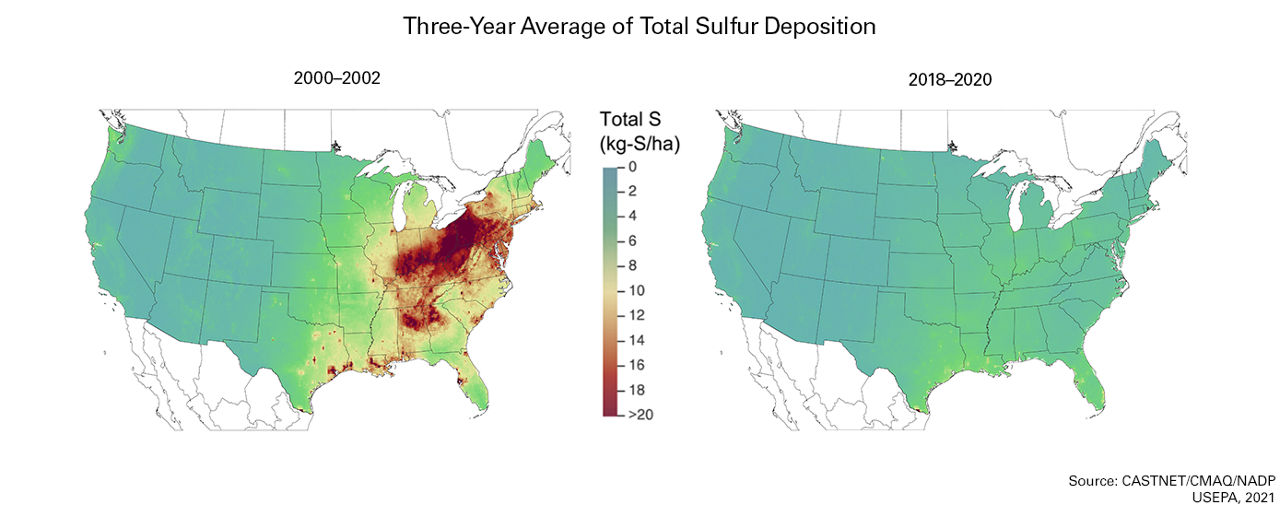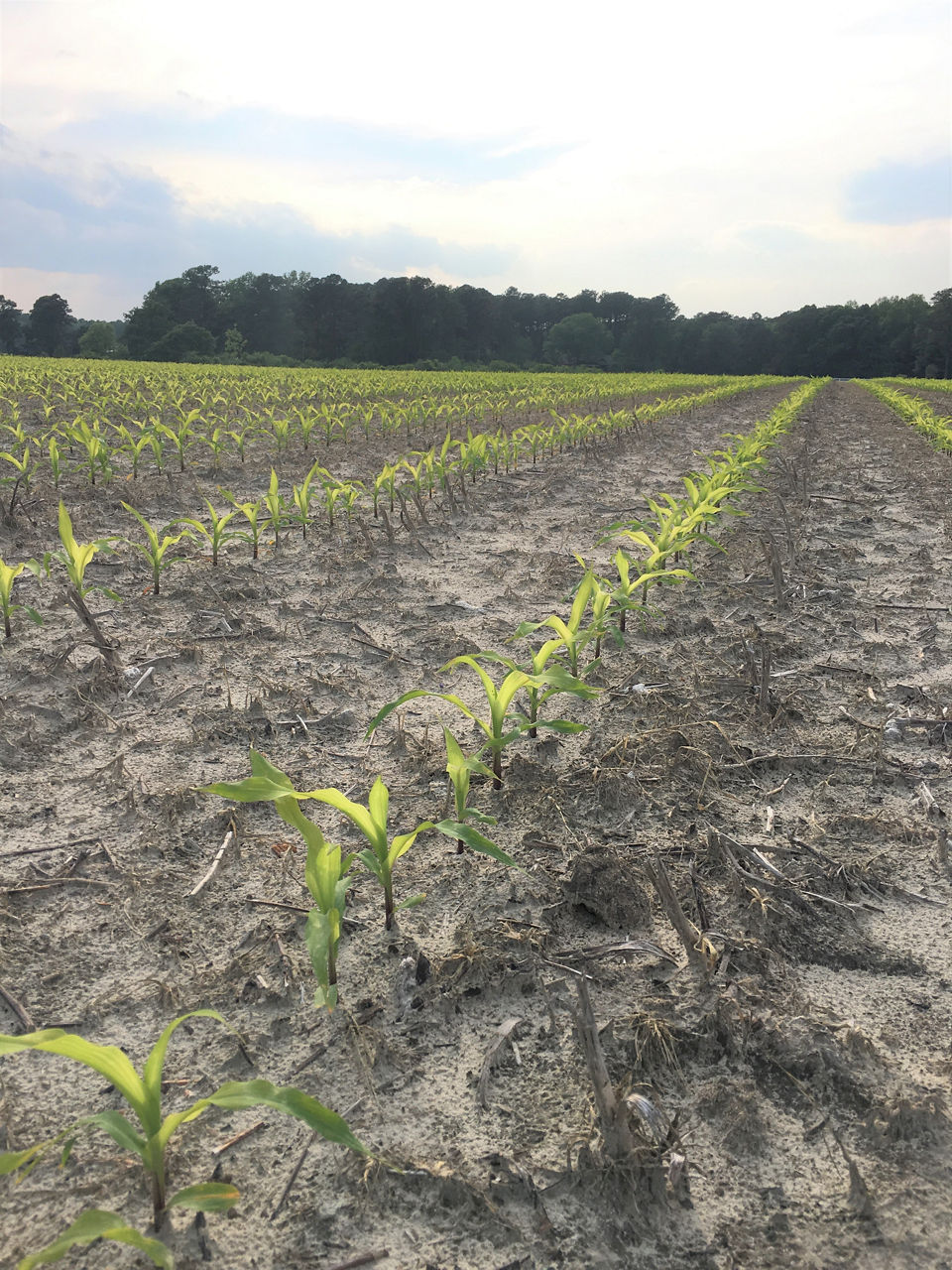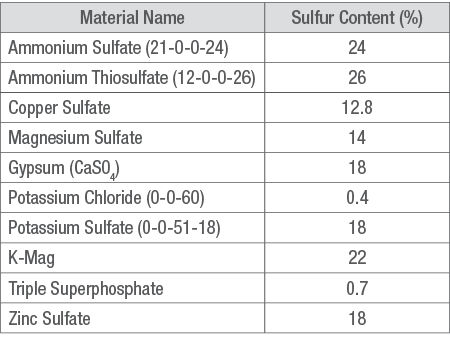5 MIN READ
The Importance of Sulfur for Corn and Soybeans
January 11, 2023
Sulfur (S), a macronutrient, is one of 18 essential nutrients that are required for plant growth from seed to seed. Sulfur plays a key role in protein synthesis and is required for many plant functions, including photosynthesis, chlorophyll formation, and nitrogen fixation. Plants deficient in S can show reduced plant development and delayed maturity. The requirement for additional sulfur in crop production has increased over the past several decades. Tissue sampling should be done to assess the need for sulfur in addition to sulfur management in your crop.
Sources of Sulfur for Plants
Soil Organic Matter: Sulfur appears in different forms in the environment. About 95 percent of the total sulfur in soils is found in organic matter, which remains unavailable to the plant until it is converted, or mineralized, to the sulfate form (SO4-S). Only 3 to 5 pounds of S are mineralized each year per percent of organic matter in the top 6-inches of soil. The rate of mineralization is dependent on soil moisture, temperature, and the carbon to sulfur (C:S) ratio. Conservation tillage systems can further slow the rate of mineralization due to a higher C:S ratio and lower soil temperatures.1
The Atmosphere: Sulfur is present in the atmosphere as sulfur dioxide (SO2) and hydrogen sulfide (H2S). Both forms enter the atmosphere through natural events like volcanic activity or man-made activities like the burning of fossil fuels. Sulfur enters the soil in solution through rainfall or the deposition of plant and animal residues.1,2
Sulfur Deficiency
Increasing S deficiency has been diagnosed in corn and soybeans in recent years.3 Sulfur deficiency is more common now because of reduced atmospheric S deposition, increasing crop removal of S, greater use of no-till, and high amounts of crop residues. The reduction of sulfur dioxide (SO2) emissions in the atmosphere from anti-pollution laws in recent years, have dramatically reduced the levels of S deposited on the soil from the atmosphere. Figure 1 illustrates the change in the amount of sulfur deposited in the United States between 2000-2002 compared to 2018-2020. Along with the decrease in atmospheric deposition, S removal has also decreased due to increasing crop yield and subsequent removal in addition to a reduction in the use of sulfur-based pesticides. For example, corn and soybean yields have increased about 1.8 and 0.4 bushels per acre per year, respectively in recent years. Increasing grain yield results in greater crop S removal from the field. A 200-bushel corn crop harvested for grain removes about 16-lbs S per acre (25 to 30-lbs per acre for silage), half of which is taken up after tasseling.1 Roughly 10-lbs S per acre is removed from a 65-bushel soybean crop, or 0.16-lbs S per bushel of soybean.2
Like nitrate, SO4-S is mobile in the soil and is subject to leaching out of the root zone. Excessive rainfall can accelerate leaching of sulfate through the soil, especially in sandy soils.1 Therefore, soil levels of S are not being replaced fast enough relative to the amount of S being leached or removed.
In addition, the timing of S availability is critical for plant growth and development. Soil mineralization by microorganisms and the creation of plant available S from soil organic matter and plant debris, occurs more efficiently when temperatures are warmer. Cold and wet temperatures limit available S and plants are more likely to show deficiency symptoms in the spring. Similarly, no-till soils are typically colder and S availability more limited under this type of agronomic practice.3 The addition of sulfur is particularly beneficial on soils with under 2% organic matter and in coarse textured soils. Sulfur typically does not need to be added in fine textured soils or fields with manure history.

Symptoms of Deficiency
When sulfur is deficient, plants become pale in color, growth is stunted, and maturity is delayed. In corn, S deficiency is displayed as an overall yellow appearance, similar to nitrogen (N) deficiency. However, because sulfur is immobile in the plant, symptoms appear first on younger leaves; whereas N deficiency symptoms appear first on older leaves. Striped leaves in corn is also a symptom of S deficiency, and may be confused with magnesium, manganese, or zinc deficiency. In soybeans, yellowing of the plant, starting in the upper canopy, is an indication of S deficiency. Early season deficiency symptoms may occur under cool soil conditions before young plants have a fully developed root system (Figure 2).2,4,5 However, plants are likely to overcome this as soils warm and root mass increases to capture available S from sulfur mineralization.2 If a S deficiency is misdiagnosed as a N deficiency, the application of fertilizer N will make the S deficiency worse; therefore, tissue sampling is recommended to positively identify which nutrient is deficient.

How to Manage Sulfur Deficiency
Tissue Sampling- Soil tests are generally considered unreliable for predicting sulfur availability. Instead, tissue tests should be used to assess sulfur needs. Samples should be collected from both areas of suspected deficiency and healthy areas of the field for comparison. Tissue tests evaluate the S concentration in the plant as well as the nitrogen to sulfur (N:S) ratio. Since proteins within the plant require an N:S ratio of 15:1, a deficiency can still occur when the S concentration is sufficient but the N:S ratio is off.1,5 In corn, young plants with less than four leaf collars should be sampled by removing the whole plant from ½-inch above the soil surface, collecting 15 to 20 plants per area. For larger plants, collect 10 to 15 of the youngest collared leaves per sampling area. Similarly, collect 10 to 15 of the youngest fully developed trifoliate leaves per sampling area in soybeans. Samples should be placed in a paper bag and shipped to a testing laboratory.3
Fertilizer Considerations- Soil texture, organic matter, crop rotation, and manure history are all important factors when predicting the need for additional S. Since S is used by the crop throughout the entire growing season and is prone to leaching from the root zone, applications should be made as close to the crop need as possible. Sulfur should be applied annually in fields where a response is predicted, such as sandy soils and fields with low organic matter. Based on studies across the Midwest in corn production, 25-lbs S per acre broadcast, or 10 to 12-lbs S per acre applied in a starter fertilizer is sufficient in sandy soils. For medium to fine textured soils, 10 to 15 lbs S per acre broadcast is the suggested rate.1,3 Soybeans generally require less sulfur than corn; however, soybean response to S application has been recently observed.6 The University of Minnesota suggests that 10 to 15-lbs S broadcast per acre should be adequate for soybeans in at-risk fields.7 There are several fertilizer options that can be used to supply S (Table 1). Sulfate sulfur (SO4-S) should be applied, as it is readily available for plant uptake. Liquid fertilizer containing S can be damaging to emerging crops and should not be applied directly on the seed.1 Manure is a good source of S, fields with a history of manure application typically do not need additional S.
Since we can no longer rely on atmospheric deposition, crops must get their S through the mineralization of organic matter and supplemental fertilizer. The addition of S in some areas can produce dramatic results, helping to increase yield and profit potential in corn and soybean production.4,8,9
Table 1. Sulfur content of common fertilizers, Source: Kaiser, D.E., and Vetsch, J.A. 2022. Sulfur for Minnesota soils. University of Minnesota Extension.

Sources
1 Kaiser, D.E., and Vetsch, J.A. 2022. Sulfur for Minnesota soils. University of Minnesota Extension. https://extension.umn.edu/micro-and-secondary-macronutrients/sulfur-minnesota-soils/.
2 Place, S., Kilcer, T., Ketterings, Q., Cherney, D., Cherney, J. 2007. Sulfur for field crops. Fact Sheet 34. Cornell University Department of Crop and Soil Sciences. http://nmsp.cals.cornell.edu/.
3 Camberato, J., and Casteel, S. 2017. Suflur deficiency. Purdue University Department of Agronomy. Soil Fertility Update. www.agry.purdue.edu/.
4 Olson, R. 2021. Is sulphur the missing ingredient? TSI Review. The Sulphur Institute. www.sulphurinstitute.org/.
5 Sawyer, J. 2020. Is it nitrogen or sulfur deficiency symptoms? Iowa State University Extension and Outreach. Integrated Crop Management. https://crops.extension.iastate.edu/blog/john-sawyer/it-nitrogen-or-sulfur-deficiency-symptoms/.
6 On-Farm Network Summary Sheet 2012-NB06. Soybean Sulfur Status. http://www.iasoybeans.com/.
7 Kaiser, D. 2013. Does my soybean crop need sulfur? University of Minnesota Extension. http://blog-crop-news.extension.umn.edu/.
8 Parker, K. 2022. Sulfur deficiency in corn can lead to lower yields. University of Illinois Extension. Good Growing Blog. https://extension.illinois.edu/blogs/good-growing/2022-06-24-sulfur-deficiency-corn-can-lead-lower-yields/.
9 Sergeant, D. 2019. Sulfur for Soybeans could mean higher yields. Lancaster Farming. https://www.lancasterfarming.com/farming-news/field_crops/sulfur-for-soybeans-could-mean-higher-yields/article_5153e422-33b3-11e9-ac20-ef49631d07f2.html/.
1113_63877